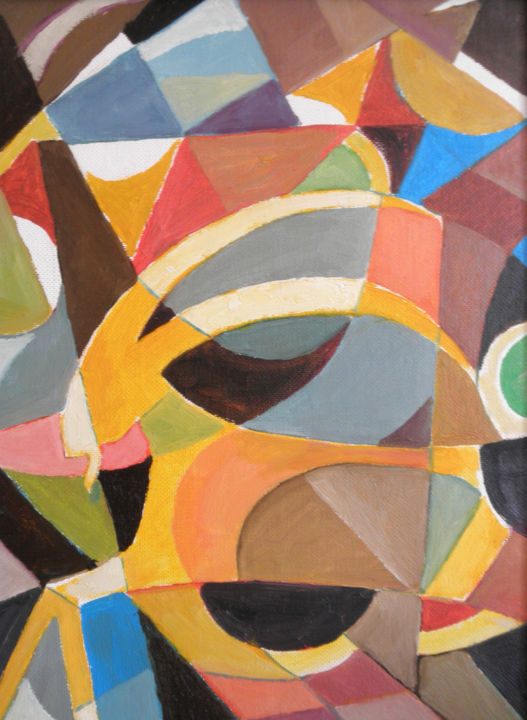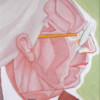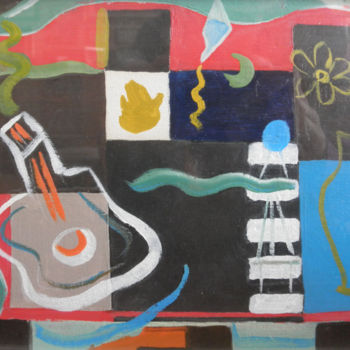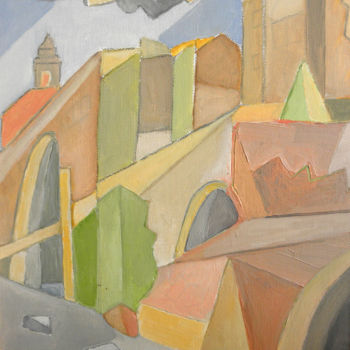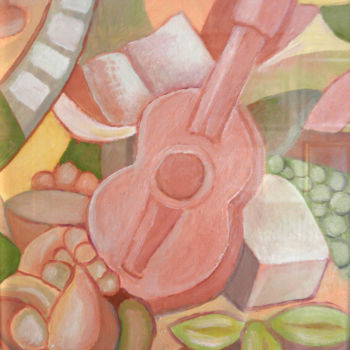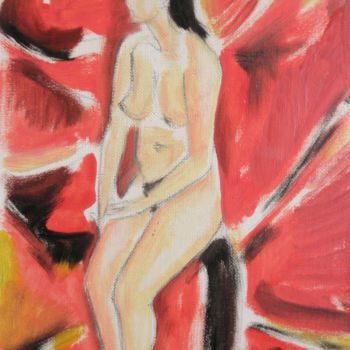Purgatorio Canto XXVII Painting by Luigi Cavalieri
Sold
Sold by Luigi Cavalieri
This image is available for download with a licence
Sold by Luigi Cavalieri
-
Original Artwork (One Of A Kind)
Painting,
Tempera
on Canvas
- Dimensions Height 9.8in, Width 7.9in
- Framing This artwork is framed (Floating Frame)
- Categories Paintings under $500 Abstract
Purgatory, Canto XXVII is a testimony to the painter’s love and cultural enthusiasm for Dante Alighieri.
In this Canto, Dante starts his ascent of the staircase that leads to the Earthly Paradise, which is hewn into the rock and faces eastwards.
As night descends, the poet lays down exhausted on a step, as also his companions. To describe his predicament, Dante liken himself to a goat who feeds on the mountains and ruminates peacefully in the shade during the day, whist during the night it is looked after by the shepherd who takes care of his animals and protects them from wild beasts.
Dante is unable to see much of what surrounds him because of the high wall of the staircase above him, but he can, nevertheless, see starts in the sky and these seem to him even brighter and bigger. In the end he is overcome by his weariness and falls asleep.
The painting decomposes the long afternoon mixing the warm shapes of day with the blackness of night, roughly intermingled, as if to depict the confusion and effort experience by a tired Dante.
The goat appears in the foreground from the window of the poet’s own imagination, expanding into the whole painting and thus joining the real with the metaphorical.
The stars in the sky are big and bright, just as Dante describes them, signified by the curved shape in the background and by white paint that appears set apart, as little flickers of light.
DIMENSIONS
The dimensions indicate the size of the canvas. It is possible to buy the work with or without its frame. The frame is little more big than the canvas itself.
ITALIANO
Purgatorio, Canto XXVII riflette l'amore e la passione culturale che l'autore aveva per il Sommo Poeta.
Nel Canto XXII, Dante inizia la salita della scala che conduce al Paradiso Terrestre, scavata entro la roccia e rivolta ad oriente.
Mentre si fa notte il Poeta si sdraia, insieme ai suoi accompagnatori, sopra un gradino, sfinito dalla fatica. Ispirandosi a queste sue condizioni, Dante si paragona ad una capra che durante il giorno pascola sulle montagne e rumina placida all'ombra, mentre di notte viene sorvegliata dal guardiano che cura le sue bestie e le protegge dalle fiere selvagge.
Dante non può vedere molto a causa dell'alto muro della scala che lo sovrasta, ma riesce comunque a scorgere le stelle in cielo che gli sembrano più grandi e luminose. Alla fine, vinto dalla stanchezza, si addormenta.
Il quadro scompone il lungo pomeriggio mischiando le forme calde del giorno con la nera notte, confusamente intermezzate, come a rappresentare lo sforzo e la confusione che la fatica crea in Dante.
La Capra appare in primo piano dalla finestra dell'immaginazione del poeta, allargandosi a tutto il dipinto e unificando così la realtà con la metafora.
Le stelle nel cielo sono grandi e luminose, come il Poeta stesso le descrive, rappresentate dalle forme curve dello sfondo e dal bianco che appare isolato, in piccoli barlumi.
Dimensioni
La tela è circondata da una semplice cornice nera che non varia di molto le dimensioni reali dell'opera.
Related themes
Luigi Cavalieri was born into a family originating from the central Italy region of Le Marche. He was born in Parma, where his father, Achille Cavalieri, a State Railway employee, had been seconded for work.
His mother, Emilia, was the daughter of Giambattista Perugini and his wife Livia Valentini, who were landowner with ties to the area of Borgo Stazione near the town of Serra San Quirico, but they also owned properties in the nearby areas, including Rotorscio and Castelletta.
The family is well know to all that live in Borgo Stazione because of the many donations they made to the local church, the building of which was financially supported particularly by two of Luigi’s uncles, Giacomo ( known as Nio), and Giulio Perugini.
Luigi’s father came from a more modest background from a family based in the small town of Serra San Quirico itself.
Luigi Cavalieri spent his childhood in Tuscany, mainly in Siena then, in 1934, he moved with hi family to Rome where his father was promoted to head of all travelling staff in the State Railway.
Here Luigi attended high school at the Umberto I ‘liceo classico’ (today known as Pilo Albertelli), where he later was destined to return as a member of staff in the 1970’s and where he also held the vice-headmaster position for a few years.
His passion in school was mediaeval poetry, particular the works of Dante and Poliziano, and he went on to study classical literature at Rome University, La Sapienza, from where he graduated with honours in Italian Literature. He then became a teacher with a permanent position as teacher of Italian and Latin in high school.
During his university years Luigi also studied Paleography and Diplomacy at the Vatican Archive Pontifical School and was granted access for study purposes to documents to which ‘imprimatur’ [the official permission to publish by the Vatican authorities N.d.T] also stored in that archives.
His familiarity with the Vatican Archive was to pay dividends later on when he conducted his research on the history and customs of Serra San Quirico.
In the late 1980’ Luigi Cavalieri achieved the qualifications to become high school headmaster by passing the required state examinations and his last appointment in this position was at the Istituto Magistrale Maria Mazzini in Rome.
In recognition to is services to the state both as teacher and headmaster, the Italian State granted him the title of Cavaliere Ufficiale della Rpubblica Italaina at the end of his career.
During his retirement, lasting many years and ending with his death at the age of 98 on 7 March 2018, Luigi Cavalieri could dedicate himself even more to his artistic activities, a passion he has cultivated all his life. His painting reveal the full range of his intellectual and cultural internal life. They are mainly executed in the medium of tempera on canvas
His sketches using pen and works in ink are also of note.
One should also not neglect to mention the long standing research and passion Luigi Cavalieri held for Dante Alighieri’s poetry. Throughout his life he produced several sketches and works on subjects extracted from the Divina Commedia.
-
Nationality:
ITALY

- Date of birth : 1919
- Artistic domains:
- Groups: Contemporary Italian Artists

